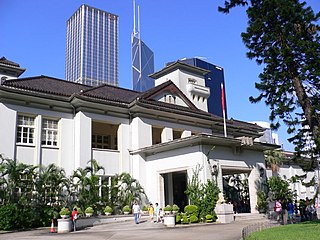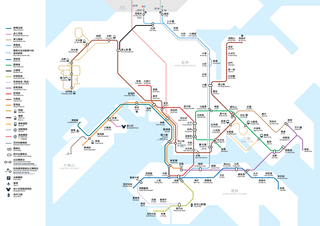
The chief executive of the Hong Kong Special Administrative Region is the representative of the Hong Kong Special Administrative Region and head of the Government of Hong Kong. The position was created to replace the office of governor of Hong Kong, the representative of the monarch of the United Kingdom during British rule. The office, stipulated by the Hong Kong Basic Law, formally came into being on 1 July 1997 with the handover of Hong Kong from the United Kingdom to the People's Republic of China.

Sir Donald Tsang Yam-kuen is a former Hong Kong civil servant who served as the second Chief Executive of Hong Kong from 2005 to 2012.

Regina Ip Lau Suk-yee is a Chinese politician. She is currently the Convenor of the Executive Council (ExCo) and a member of the Legislative Council of Hong Kong (LegCo), as well as the founder and current chairperson of the New People's Party. She was formerly a prominent government official of the Hong Kong Special Administrative Region (HKSAR) and was the first woman to be appointed the Secretary for Security to head the disciplinary service. She is also the founder and Chairwoman of Savantas Policy Institute, a think-tank in Hong Kong.

Government House, located on Government Hill in Central, Hong Kong, is the official residence of the Chief Executive of Hong Kong. It was constructed in 1855 as a Colonial Renaissance-style building, but was significantly remodelled during the Japanese occupation, resulting in the current hybrid Japanese-neoclassical form.
Declared monuments of Hong Kong are places, structures or buildings legally declared to receive the highest level of protection. In Hong Kong, declaring a monument requires consulting the Antiquities Advisory Board, the approval of the Chief Executive of Hong Kong as well as the publication of the notice on the Hong Kong Government Gazette.

Ronny Tong Ka-wah, SC KC is a Hong Kong Senior Counsel and politician. He is a current non-official member of the Executive Council of Hong Kong. He co-founded the Civic Party and was a member of the Legislative Council of Hong Kong, representing the New Territories East constituency from 2004 until he quit the party and resigned from the legislature on 22 June 2015, following the historic vote on Hong Kong electoral reform a few days earlier, having switched his political alignment from pro-democracy to pro-Beijing Hong Kong political group Path of Democracy, of which he is currently the convener.

Several future projects on the MTR have been put forward by the MTR Corporation to the Hong Kong Government. Some of these are still in planning stage.

Kwu Tung is a planned underground infill station on the Lok Ma Chau spur line of the East Rail line of the MTR rapid transit network in Hong Kong. The station will be situated near Kwu Tung in North District, New Territories.

Ta Kwu Ling is an area in the North District, New Territories, Hong Kong, located northeast of Sheung Shui, close to the border with mainland China and south to Liantang Subdistrict in Shenzhen.

The Antiquities Advisory Board (AAB) is a statutory body of the Hong Kong Special Administrative Region with the responsibility of advising the Antiquities Authority on any matters relating to antiquities and monuments. The AAB was established in 1976 along with the Antiquities and Monuments Office (AMO) when the Antiquities and Monuments Ordinance (Cap. 53) was enacted, and comprises members appointed by the Chief Executive. The corresponding governmental ministry is the Development Bureau, and executive support for the AAB is provided by the AMO which is under the Development Bureau.

The Hong Kong Golf Club is a private golf club. It is home to the Hong Kong Open, a tournament co-sanctioned by the European and Asian Tours.
The Northern Link is a proposed rapid transit line of the MTR system of Hong Kong which would connect the Tuen Ma line and the Lok Ma Chau Spur Line of the East Rail line. The link would also serve as a connection to the border checkpoint to mainland China for passengers to and from the western New Territories. The Northern Link would start at Kam Sheung Road and end at Kwu Tung, and would be constructed either as a direct shuttle or with intermediate stations.

Jeffrey Lam Kin-fung, GBS, JP is a non-official member of the Executive Council (Exco) and member of the Legislative Council (Legco), representing the Commercial (First) functional constituency. He is currently the vice-chairman of the pro-business pro-Beijing Business and Professionals Alliance for Hong Kong (BPA).

Kwu Tung is an area in the northern New Territories, west of Sheung Shui and Fanling, and east of Lok Ma Chau and San Tin, in Hong Kong.

Nga Tsin Wai Tsuen, also known as Hing Yau Yu Tsuen was a walled village in Wong Tai Sin, Kowloon, Hong Kong with a history spanning more than 600 years.

Tai Ho Wan or Tai Ho Bay is a bay on the north shore of Lantau Island in the New Territories of Hong Kong. It is located west of Siu Ho Wan, and northeast of Tung Chung and Kei Tau Kok. The surrounding land was originally planned to be part of the North Lantau New Town scope, but there is a current slowdown in its plans because of the lack in population growth and environmental groups opposed to the next in abeyance.

The North District Council is one of the 18 Hong Kong district councils and represents the North District. It is one of 18 such councils. Consisting of 24 members, the district council is drawn from two constituencies, which elect 4 members, along with 8 district committee members, 8 appointed members, and four ex officio members who are the Ta Kwu Ling, Sheung Shui, Sha Tau Kok and Fanling rural committee chairmen. The latest election was held on 10 December 2023.
Terence Stanley Crathern Feltham (1896–1971) was Chief Architect in the Public Works Department of Hong Kong.
Oi Yuen Villa is a privately owned villa located in Kwu Tung, Sheung Shui, Hong Kong. The building has been listed as a Grade I historic building since June 2017.
The Hong Kong 2030: Planning Vision and Strategy is a study group tasked with preparing a strategic land use planning framework for Hong Kong up to year 2030. The HK2030 Study aimed to provide strategic framework for future land use in New Territories to address long-term housing demands in the New Development Areas (NDAs) of Kwu Tung North (KTN) and Fanling North (FLN). In 2008 “The North East New Development Areas Planning and Engineering Study” began; it continued until 2013.




















